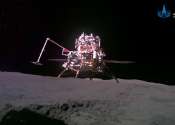NASA's Curiosity rover discovers a surprise in a Martian rock
Scientists were stunned on May 30 when a rock that NASA's Curiosity Mars rover drove over cracked open to reveal something never seen before on the Red Planet: yellow sulfur crystals.

Scientists were stunned on May 30 when a rock that NASA's Curiosity Mars rover drove over cracked open to reveal something never seen before on the Red Planet: yellow sulfur crystals.
Planetary Sciences
Jul 18, 2024
5
378

Some scientists dream of exploring planets with "smart" spacecraft that know exactly what data to look for, where to find it, and how to analyze it. Although making that dream a reality will take time, advances made with ...
Planetary Sciences
Jul 16, 2024
0
14

Japanese scientists have used human cells to develop an equivalent to living skin that can be attached to robotic surfaces to flash a realistic—if creepy—smile.
Materials Science
Jun 27, 2024
0
102

After six months of effort, an instrument that helps the Mars rover look for potential signs of ancient microbial life has come back online.
Planetary Sciences
Jun 26, 2024
0
590

A Chinese probe carrying samples from the far side of the moon returned to Earth on Tuesday, capping a technically complex 53-day mission heralded as a world first.
Space Exploration
Jun 25, 2024
18
48

Technicians armed with advanced measuring equipment, augmented reality headsets, and QR codes virtually checked the fit of some Roman Space Telescope structures before building or moving them through facilities at NASA's ...
Space Exploration
Jun 21, 2024
0
14

Researchers from Tohoku University and Kyoto University have successfully developed a DNA-based molecular controller that autonomously directs the assembly and disassembly of molecular robots. This pioneering technology marks ...
Bio & Medicine
Jun 14, 2024
0
28

A spacewalk scheduled for two astronauts outside the International Space Station was canceled by NASA about an hour before it was to begin Thursday morning.
Space Exploration
Jun 13, 2024
2
17

Fine motor tasks under space conditions are particularly challenging and must first be trained on Earth. Scientists from the German Research Center for Artificial Intelligence (DFKI) and the University of Duisburg-Essen (UDE) ...
Space Exploration
Jun 12, 2024
0
7

Flexible piezoelectric sensors are essential to monitor the motions of both humans and humanoid robots. However, existing designs are either costly or have limited sensitivity.
Nanomaterials
Jun 12, 2024
0
8
Robot is a virtual or mechanical artificial agent. In practice, it is usually an electro-mechanical system which, by its appearance or movements, conveys a sense that it has intent or agency of its own. The word robot can refer to both physical robots and virtual software agents, but the latter are usually referred to as bots. There is no consensus on which machines qualify as robots, but there is general agreement among experts and the public that robots tend to do some or all of the following: move around, operate a mechanical limb, sense and manipulate their environment, and exhibit intelligent behavior, especially behavior which mimics humans or other animals. In South Africa, robot is an informal and commonly used term for a set of traffic lights.
Stories of artificial helpers and companions and attempts to create them have a long history but fully autonomous machines only appeared in the 20th century. The first digitally operated and programmable robot, the Unimate, was installed in 1961 to lift hot pieces of metal from a die casting machine and stack them. Today, commercial and industrial robots are in widespread use performing jobs more cheaply or with greater accuracy and reliability than humans. They are also employed for jobs which are too dirty, dangerous or dull to be suitable for humans. Robots are widely used in manufacturing, assembly and packing, transport, earth and space exploration, surgery, weaponry, laboratory research, and mass production of consumer and industrial goods.
Modern robots are usually used in tightly controlled environments such as on assembly lines because they have difficulty responding to unexpected interference. Because of this, most humans rarely encounter robots. However, domestic robots for cleaning and maintenance are increasingly common in and around homes in developed countries, particularly in Japan. Robots can also be found in the military.
This text uses material from Wikipedia, licensed under CC BY-SA